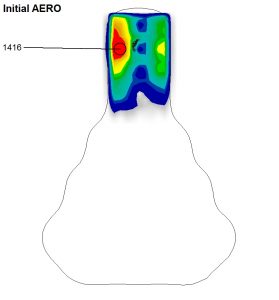THE PERFECT SADDLE POSITIONING IN TRIATHLON
When having a look at the saddle positioning of many middle- and long-distance triathletes, it becomes obvious that often the athlete only uses the saddle tip on the bike split. The back part of the saddle is visible, as the pelvis has no contact to the saddle behind the tip. For many, this seems inevitable as they believe that in an aggressive aero-position it is impossible to use the entire saddle.
But: Is this really so? Is it true that only the saddle tip can be used to position the pelvis? What consequences is this positioning likely to have? Let’s take some time to address these questions using a recent case:
Our case uses a male triathlete, who is doubtlessly ambitious in his discipline. We have analysed his bike position – aka his bike fit – considering the resistance he is pushing for several hours in racing constantly.
Figure 2 shows his pressure distribution on the saddle in the tri-position (starting position). It is striking how small the contact surface in the area of the saddle tip is. The strained surface is ‘only’ 4650mm2, based on our experience this is small even for triathletes. The small contact surface also explains the high maximum pressure of 1416 mbar. As pressure is defined as force / area, a small surface automatically results in heightened peak pressure. Over time, these peaks can lead to saddle discomfort. Often, the athlete compensates for the lacking comfort by increasing the movement of the hip, which is potentially counterproductive in terms of aerodynamics. In the worst case, the athlete needs to change to riding holding the hoods – a position in which everything is lost from an aerodynamics perspective.
As measures for improvement, we have adjusted both the saddle height and the saddle positioning by 5mm each. These measures were based on the analysis of the pressure distribution in conjunction with analysing the angles of the knee, hip and ankle joints.
The following video shows the PRE (left) and POST (right) comparison of the saddle pressure measurement.
When analysing the new saddle position, it is clear that the contact surface has considerably enlarged. The surface is 11.750mm2 now, equalling an increase of 152%. This also results in a reduced maximum pressure of 765mbar (minus 46%), an additional important difference to the starting position. It is visible that in this position larger parts of the pelvis are supported. Accordingly, the pubic rami can bear part of the weight, while in the starting position the area of the pressure-sensitive pubic symphysis carried the entire weight. The center of pressure on the saddle moved backwards by 38mm.
Here’s an overview of the values:
As the athlete’s first feedback also was positive, we continued working with this position during the remainder of the bikefitting session.
Conclusion:
Even if an aggressive triathlon position naturally results in a higher pressure on the pubic area, it is still worthwhile to pay detailed attention to the contact point saddle in every TRI-fitting. It is often the small changes (in the area of a few millimetres) that can considerably improve saddle comfort and pelvic stability. As small details have large consequences, adjusting the saddle positioning cannot be solely based on considering the knee and ankle angles. These details contribute to how successful the athlete will be on the bike split. The adjustment of the entire cockpit must not be disregarded in the process – but to cover this, I will need to write another blog post ;-)
Author: Daniel Schade



